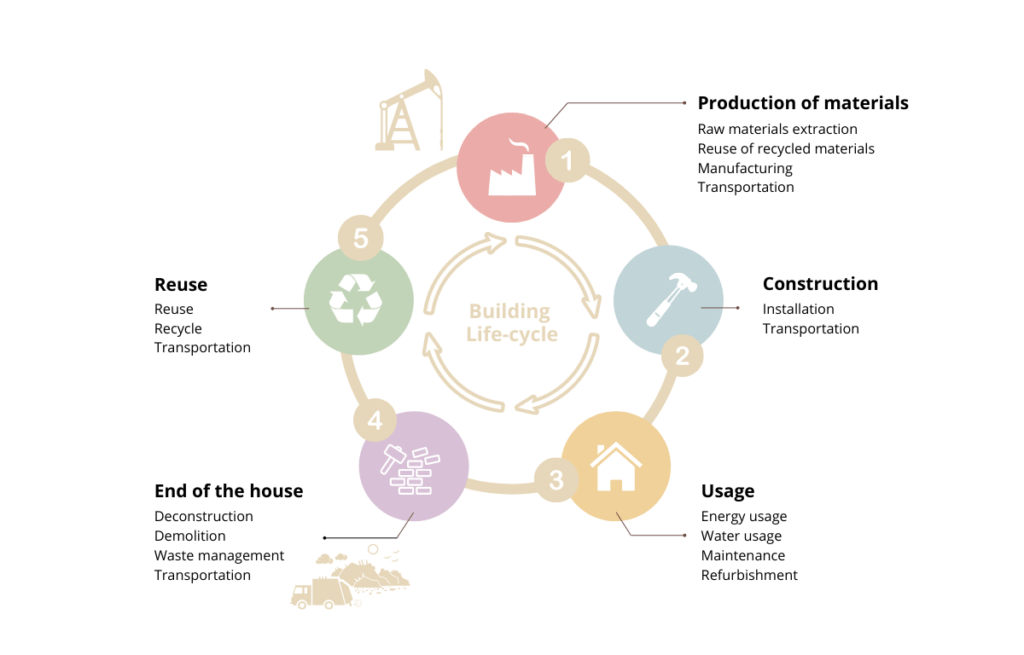The building life cycle refers to the stages a building goes through from construction to operation, and eventual demolition and recycling. Implementing the building life cycle in practice involves considering the various stages and making informed decisions at each step to ensure the building’s sustainability, efficiency, and long-term performance.

*Due to lack of comparison data and incorrect system calculated results, we used our own methods for comparison calculations
Problems we found with the concept
To start with, we absolutely appreciate the concept as it helped us set many priorities, but before jumping into explaining how we used the building life cycle for design and planning and how it helped us, we want to emphasise that it’s a general framework which also has limitations from our perspective and certainly doesn’t solve micro-level decision making dilemmas.
Complexity: In practical applications, the level of detail and the specific factors to consider can very significantly dependent on the project size, location and type.
Time and Resource: Implementing the concept requires time, effort, and resources to gather data, think of methods how to analyse, and make informed decisions at each stage and for many smaller details. And when the analysis is done, it’s still a prediction and dependent on the methodology used.
Limited Data Availability: Accurate and reliable data is basically impossible to get due to the amount of variables involved.
Uncertainty and Future Predictions: Predicting future trends, changes in technology, and user needs is not easy and some choices made may not align optimally with future needs.
Integration Challenges: Balancing diverse interests (e.g. client, architect, projector and builder) and ensuring everyone’s input is wanted and considered can be challenging.
Incomplete Scope: While the building life cycle model covers the typical stages, going into each detail is difficult and the concept is useful only on macro level.
Despite these limitations, the building life cycle model remains a valuable framework for guiding decision-making and promoting sustainability in building. To overcome some of these challenges, it’s essential to adapt the model to suit the specific needs and constraints of each project while still striving for sustainable practices and long-term value.
Now to our experiences.
ODYL and “Materials”
The top 3 priorities that we listed for choice of materials were the following
Production location
We consider the production site of all materials (up to screws). The goal is that all materials are produced within the EU and source materials for most important materials (e.g. wood) are local.
Quality
We have to choose materials that have the best possible price quality relationship. It is finally cheaper for us to use better materials since they last longer, but importantly, they are easier to handle and build with.
Transportation
We need to purchase the materials for one house at once to avoid picking up materials again and again and again. Major resource saver.
ODYL and “Construction”
The top 3 priorities that we listed for the construction stage were the following
Design
We design the house and its add-ons in a way that would require minimal labour resource for building the elements as well as to install them.
Transportation
We design the elements of the house to pack a trailer 100% and leave no “air” for transportation.
Craftsmanship
We only hire people who are excellent craftsmen and thing along with the process to improve it.
ODYL and “Usage”
The top 3 priorities that we listed for the usage stage were the following
Energy efficiency
We need to design and build the house to be energy efficient and use the seasonal natural and solar energy available to its maximum.
Maintenance
We need to design the house to have minimal maintenance and refurbishment need throughout the usage years. We need the house to have easily changeable elements (e.g. wires).
Monitoring
We need technology to monitor usage and help the clients maintain the house.
ODYL and “End of the life cycle (inc. recycling)”
The top 3 priorities that we listed for the usage stage were the following
Recyclability
We need to choose materials and building techniques that allow the house to be future-proofed and 100% recyclable.
Reuse
We need to make the house a “lego” that can be deconstructed and put back together.
Monitoring
We need technology to monitor usage and help the clients maintain the house.
Summary of our experience
We couldn’t use the existing building life cycle assessment tools (we tried, but for a small house they are not useful). Having said that, we believe using existing tools for medium sized and large developments would make a massive difference for the construction sector’s overall impact and sustainability. Especially considering that construction and housing are the most influential sectors for the climate, our ecosystems as well as social structures.
To sum it all up, the concept was very useful for us to list priorities and always have them in front of our eyes (=mind) when discussing and analysing concepts as well as smaller details. Therefore, we can say from a small project perspective that it does help to stay focused and come up with or choose more sustainable solutions. Keeping focus helps with pushing the limits and innovating bit by bit, detail by detail; whereas at the end, all the details together make a difference.

